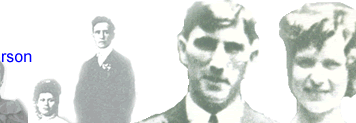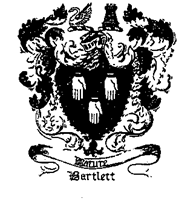Conqueror's Spoils
"The record shows that Adam de Berthelot was amongst the first to be given land, receiving 6000 acres along the River Arun in Sussex, stretching from Northam to, and including, the hamlet of Stopham after which the estate was named. That he was not retained for military service and got the grant so soon and able to take up residence there not long after, all point to him having received injuries in the battle severe enough to incapacitate him."
Adam de Berthelot was seventh in descent from Prince Berthelot, nephew to Charlemagne and it is to Liseux and the country surrounding it along the River Touques in Normandy that we must turn to pick-up the thread of our history, for it was there in the fateful year 1066 that Adam de Berthelot was living as a minor nobleman.
Liege overlord for the district was Count Guido de Brionne - a member of the de Brionne family, Dukes of Burgundy - whose castle known as "Brionne" stood a mile or so from Liseux and is to-day harked by the small town of the same name. Not far away there also lived the de Montgomery family, close friends of Guillaume, Duke of Normandy, and as will be seen as this history unfolds, the Roger de Montgomery from here was to become an influential friend of those close to him after the Norman invasion of England, where this same Roger became known as "Arundel".
When the Duke of Normandy took the decision to carry out that invasion and gathered together an army for the purpose, virtually all who owed him allegiance (as well as others invited to participate for a share in the spoils!) were called upon to assemble, bringing with them men and materials.
Among those so commanded was Guido de Brionne, who in turn gathered together all those sworn to serve him: it is known that one of these was Adam de Berthelot, who is understood to have been chosen by de Brionne as his personal esquire as well to have brought family retainers with him. That appointment as esquire demanded a rather special oath of fealty and service to be sworn by Adam, carrying with it, as was the custom, a two-way obligation on the part of both de Brionne and Berthelot.
When the invading army was assembled, de Brionne and his contingent, including Adam de Berthelot was put under the immediate command of Robert de Mortaine but in what we might term the division led by Odo, Bishop of Bayeux. Robert and Odo were brothers and, importantly for their future and the future of those close to them, were also trusted half-brothers of the Duke of Normandy. After the successful invasion of England these family connections were to prove extremely beneficial to Berthelot and others.
And so it was that when the Normans came ashore on the beaches of Pevensey near Hastings in Sussex, on Michaelmas Day 29th September 1066, not only was the name Berthelot amongst them, but with him, the coat-of-arms bearing the left handed glove commemorating the event of two hundred years earlier.
The bloody battle of Hastings that followed ended as history tells us, with the death of Harold Godwinnson who had claimed the English throne for himself, and a great many killed and wounded on both sides. The Anglo-Saxon army was defeated, with the invaders in control of key parts of England from which to set about the country's complete subjugation.
This was not achieved quickly however; those to whom land and property had belonged continued to resist the Normans, who came to take it away, whilst there was still plenty of fight left in other parts of England, with tribes of Wales, Clans in Scotland and marauding Scandinavians ever eager to take advantage of any opportunities to plunder!
Even before being crowned King of England, Duke Guillaume had made plans for exercising the controls he knew were essential in a conquered country, and he wasted no time putting these in place. He did not disband all his army but retained the best fighting men and their commanders whom he could be sure would carry out his wishes.
The record shows that Adam de Berthelot was amongst the first to be given land, receiving 6000 acres along the River Arun in Sussex, stretching from Northam to, and including, the hamlet of Stopham after which the estate was named. (Stopham is between Pulborough and Petworthon on the Rother River, which joins the Arun a little to the west of Pulborough. Stopham has the most beautiful bridge in Sussex, dating from the fourteenth century, and a little church filled with memorials of the Bartelott family.) That he was not retained for military service and got the grant so soon and able to take up residence there not long after, all point to him having received injuries in the battle severe enough to incapacitate him, whilst the nature of the grant suggests he enjoyed influential patronage presumably from de Brionne and Mortaine since the Roger de Montgomery, also in their company, was given the huge estates that became part and parcel of the Earldom of Arundel, making him a next-door neighbour to Adam de Berthelot in Sussex!
However there is another dramatic piece of evidence of the regard with which Adam must have been held, this being the inclusion of his name upon the list of those chosen by King William himself to make up what was termed his "Roll of Honour" and accordingly inscribed upon the walls of the Abbey the King had built at Hastings to forever commemorate both his victory there and those who had served him well in the battle that is, upon the walls of Battle Abbey. (According to this source, p. 243, the insignia of the "Bartelotts of Stopham" bore three falconer's gloves pendant, symbolic of the murder of their ancestor, the nephew of Charlemagne.)
Readers will have noted the change in spelling of "Guillaume" to "William", and this brings us to so many of the changes made in England to Norman names as the result of the Anglo-Saxon scribes putting into written form the sounds being heard out of Norman mouths.
Not just the King's name was Anglicised but so also were such others as de Brionne, which became "de Bryan"; Mortaine that ultimately became "Martyn"... and de Berthelot that became "Barttelot"!
With no more than a few thousand men to control the whole of England, the King introduced a system that centralized his authority in a way never before achieved, and which turned into a single, cohesive nation those who had previously bickered and fought amongst themselves. What he did was to remain in place for hundreds of years, bringing about a social structure clearly recognizable today.
Annulling all existing land and property ownership, and after declaring one-third of all England to be "Royal Estate" owned by the Crown, King William then gave the remaining two-thirds to only eleven Normans either related or trusted and close friends.
Those so chosen became immediately extremely powerful, with vast estates that included control and authority over the people that lived within their boundaries, and presenting what on its face was an enormous administrative responsibility for them.
Bad Luck for Original Brits What if Harold had met William with fresh troops? Today we might be speaking true Anglo-Saxon and the Bartlett line as we know it would not exist! |
The King was both a realist and a pragmatist: he knew that in a newly conquered country still in a state of flux, attitudes and loyalties could change very quickly... Especially towards himself! He did two things that, above all else, ensured the continuation of his new system of governing England.
The first of these was to make very sure that each of the eleven received individual estates that were not only relatively small but separated from the rest by distance and scattered all over England, making it impossible for any of them to collect together a very large force without knowledge of it reaching royal ears!
The difficulties of looking after so many relatively small estates all over the place the King overcame by giving permission to these eleven premier Earls and Dukes the right to themselves appoint "household knights" who could be sworn to loyalty to their respective overlords. And to give to these knights and their descendants properties which, in effect, were then held by grace of that overlord. The Knights became responsible for administering and looking after such grants and for collection of taxes demanded by the Earl or Duke from whom the grant was received.
This tiered arrangements known as the "Feudal System", enabled the King to impose taxes and manpower needs upon the eleven who in turn imposed them... plus whatever was required for their own upkeep... upon the enfeoffed Knights.
It was within this scenario that Adam de Bartelot and other Normans proceeded to make new lives in an atmosphere that would have been largely hostile and made it essential for the possession of land to remain in their hands. It was to remain a matter of tradition for a long time, that no Norman male property owner should permit a daughter to marry an Anglo-Saxon for fear of this situation changing. Generally at first there were very few marriages to local women either because of this matter of land ownership or as the result of distrust and dislike for the conquerors, although this disappeared after a while.
Given these attitudes, and knowing from records that at the time of his death Adam had two sons at least in England, both old enough to hold property, it can be assumed that he was joined at Stopham by a wife who came from Liseux. The couple may well have had other offspring but if so nothing has been recorded to evidence this was the case.


